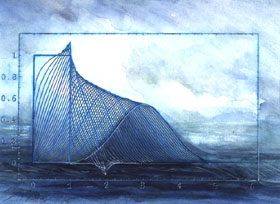Introduction
 The fractional splines are an extension of the polynomial splines for all fractional degrees α > -1.
Their basic constituents are piecewise power functions of degree α. One constructs the corresponding B-splines through
a localization process similar to the classical one, replacing finite differences by fractional differences
(c.f definitions). The fractional B-splines share virtually all the properties of the classical
B-splines, including the two-scale relation, and can therefore be used to define new wavelet bases with a continuously-varying
order parameter. They only lack positivity and compact support.
The fractional splines are an extension of the polynomial splines for all fractional degrees α > -1.
Their basic constituents are piecewise power functions of degree α. One constructs the corresponding B-splines through
a localization process similar to the classical one, replacing finite differences by fractional differences
(c.f definitions). The fractional B-splines share virtually all the properties of the classical
B-splines, including the two-scale relation, and can therefore be used to define new wavelet bases with a continuously-varying
order parameter. They only lack positivity and compact support.
The fractional splines have the following remarkable properties:
-
Generalization: for α integer, they are equivalent to the classical polynomial splines. As can be seen in the
animations below, the fractional B-splines interpolate the polynomial ones in very much
the same way as the gamma function (included in the definition) interpolates the factorials.
-
Regularity: the fractional splines are α-Hölder continuous; their critical Sobolev exponent
is α + 1/2.
-
Decay: the fractional B-splines decay at least like |x|-α-2; they are compactly
supported for α integer (α odd in the symmetric case).
-
Order of approximation: the fractional splines have a fractional order of approximation α + 1; a property
that has not been encountered before in wavelet theory.
-
Vanishing moments: the fractional spline wavelets have ceil(α)+1 vanishing moments,
while the fractional B-splines reproduce the polynomials of degree ceil(α).
-
Fractional derivatives: simple formulæ are available for obtaining the fractional derivatives of B-splines.
In addition, fractional spline wavelets essentially behave like fractional derivative operators.
-
Stretching the bounds of wavelet theory: for -1/2 < α < 0, the fractional B-splines don't have the
standard regularity factor (1+z). Yet, they yield perfectly valid wavelet bases with some rather strange
characteristics (order of approximation lesser than 1, singularities at the integers, etc...).
Despite their non-conventional properties and lack of compact support, the fractional spline wavelets are
perfectly implementable. Try our software demo, which allows you to apply a
generalized version of the Battle-Lemarié wavelet transform to some images. You can adjust the
parameter α >= 0 which is allowed to vary in a continuous fashion. The transform is orthogonal
and fully reversible.
Downlable Matlab code or Java code that implements the various kinds of fractional wavelet transform.
Reference:
M. Unser, T. Blu, "Fractional Splines and Wavelets," SIAM Review, vol. 42, no. 1, pp. 43-67, March 2000.
 The fractional splines are an extension of the polynomial splines for all fractional degrees α > -1.
Their basic constituents are piecewise power functions of degree α. One constructs the corresponding B-splines through
a localization process similar to the classical one, replacing finite differences by fractional differences
(c.f definitions). The fractional B-splines share virtually all the properties of the classical
B-splines, including the two-scale relation, and can therefore be used to define new wavelet bases with a continuously-varying
order parameter. They only lack positivity and compact support.
The fractional splines are an extension of the polynomial splines for all fractional degrees α > -1.
Their basic constituents are piecewise power functions of degree α. One constructs the corresponding B-splines through
a localization process similar to the classical one, replacing finite differences by fractional differences
(c.f definitions). The fractional B-splines share virtually all the properties of the classical
B-splines, including the two-scale relation, and can therefore be used to define new wavelet bases with a continuously-varying
order parameter. They only lack positivity and compact support.